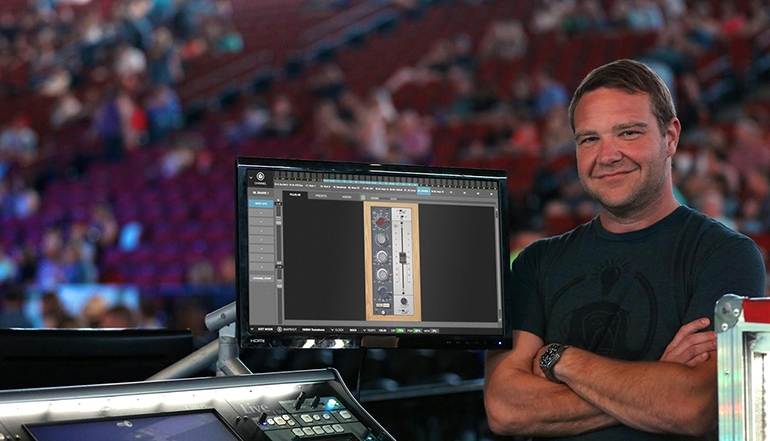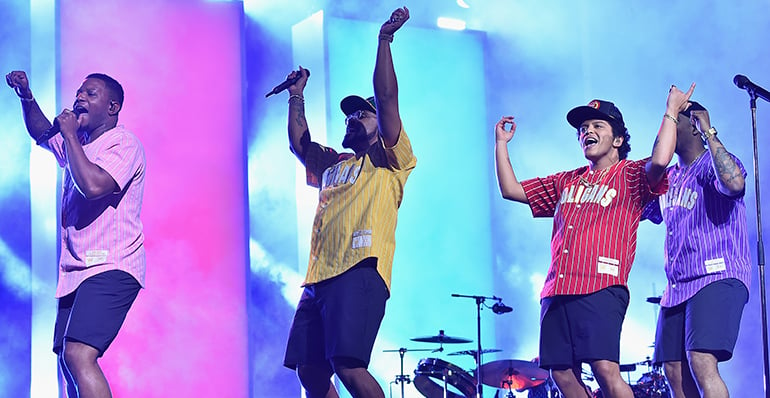Chris Rabold is well versed in the art of the larger-than-life arena mix. Early on, the veteran engineer spent more than 11 years with Widespread Panic, moving on to stints with Lady Gaga, Beyoncé, and Kenny Chesney before spending nearly two years on the road with Bruno Mars’ blockbuster 24K Magic World Tour, which hit 85 dates around the world before wrapping at the end of 2018.
When we caught up with Rabold this summer, he was between tour gigs, mixing one-offs for Bruno Mars, Kenny Chesney, and Alicia Keys. We asked him to share a few insights on choosing the key tools that make up his ideal FOH rig.
Live Design: Do you have much studio experience, and does that inform your gear choices on the road?
Chris Rabold: I knew I wanted to focus on live sound from the time I was a teenager. While I've spent enough time in a studio for it to count, I wouldn't deem myself a "studio engineer." I'm a live mixer, first and foremost. That said, the lines are so blurred these days. I draw inspiration from both worlds, and what's happening in the studio absolutely drives what I use live, particularly since many of my best industry friends are studio guys, so we all talk.
On larger tours, we'll spend a good deal of time in preproduction where my rig mimics a studio set up, mix-wise. It'll be months before I even see a PA; it’s primarily me in an isolated room with a pair of nearfields. That's where the real experimentation happens!

LD: How fast do you feel you need to respond to advances in technology?
CR: That's a great question. The end result is obviously all that matters, but how you get there goes a long way, too—especially on a perception level with artists. I think there's a comfort factor for them when they see the same or similar setups in both their studio worlds and their live worlds.
As a mixer, the more engaged and inspired I am by the tools I use, the better I'll perform, so that plays a role, too. I want my tried-and-true bits, but I want some new stuff on occasion that'll push me. Once that tour sets sail, you really don't want to be messing with things too much; the experimentation I mentioned before really does need to occur early on. The bummer there is, if it’s a long tour, it’s just you and your same gear for a while! That said, yeah, I'll still tweak along the way and add a new thing here or there if I feel it’s worth it.
LD: Do you feel confident that you’re able to create a studio-quality mix with today’s technology?
CR: I definitely think we have the means to do so. What we don't and simply won't ever have is isolation like we can have in a studio. Open microphones in less-than-ideal acoustic spaces are always going to mar our end product. But do we have the tools, the technology, and the know-how? Absolutely. You accept that parts of live sound are what they are, and then you move on with the absolute best mix you can come up with, with many of the same tools as our studio counterparts. It’s a pretty great time to be mixing live shows.
LD: Tell me about the key gear that you like to carry in your FOH rig.
CR: For a long while, I've had a very specific stereo bus chain: an API 2500 into a Sonic Farm Creamliner. That's slowly starting to evolve as of late; the introduction of the Universal Audio Live Rack has ushered in some of those changes. I'm still trying to settle on something; there's just so much to choose from in terms of saturation and color from the UA plug-ins, and the 2500 emulation is the best yet. Basically, I need some color and some excitement on the stereo bus, above all else. It's never an extreme amount of anything, but it matters.
LD: How did you come to the decision to add the Live Rack?
CR: I've been using two Live Racks at 96k since early 2018. So far that's been with both DiGiCo and SSL consoles. My friend, guitar player Kenny Greenberg, introduced me to Jason Salzman from UA around that time. They were getting ready to launch Live Rack, and I was really excited to get involved. People have been using Apollos live for a while now, but that always involved conversion. The idea of being able to access UA plug-ins via MADI, which is Live Rack's method of I/O, was too good not to try. Off we went, and I haven't looked back since. I'm honored to be involved with the platform, I really am. UA is at the top tier of plug-in design.
LD: How are you generally using it?
CR: I use it to provide inserts for dynamics control as well as color and distortion, but I also use it as an effects rack. The reverbs, delays, modulation effects, etcetera, are all incredible. I see Live Rack being used more and more in that sense: replacing people's outboard effects and upping the ante in the process.

LD: You’ve said that your rack gear is almost always master bus, rhythm section, and vocal-specific. Is that your general approach?
CR: Things change based on the tour and the instrumentation, no doubt. But yeah, I can all but guarantee you that if I have the time and budget to do so, the mix bus, rhythm section, and vocal inputs are going to be getting some extra love in the gear department!
LD: Ultimately, what kind of gear functionality and features are the most important, as you outfit your FOH rig?
CR: It’s gotta make a real difference, first and foremost. Otherwise, it’s an unnecessary potential point of failure. We don't get any do-overs live, so if I'm gonna use something, it has to warrant the risk. I'll gain-match everything I manipulate to the original source, in and out of context of the mix. As long as the newly altered one is legitimately better and not just louder, then it’s a keeper.
I'm not a huge fan of overly complex GUIs, either. I just want to mix, ya know? I like functionality but I don't like being overwhelmed by seven million options.
Finally, when it comes to live work, the day-in, day-out reliability of the gear has got to be there. That really goes without saying. "Reliability" can mean a number of things: I want something that works, not something that'll eventually work by show time but you might have a heart attack while its issues are being sussed out. That's when a piece of gear just isn't worth it anymore.
Sarah Jones is a writer, editor, and content producer with more than 20 years' experience in pro audio, including as editor-in-chief of three leading audio magazines: Mix, EQ, and Electronic Musician. She is a lifelong musician and committed to arts advocacy and learning, including acting as education chair of the San Francisco chapter of the Recording Academy, where she helps develop event programming that cultivates the careers of Bay Area music makers.